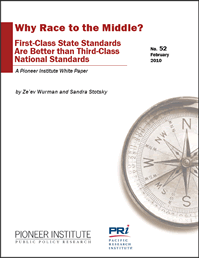Read PDF Study
Executive Summary
The case for national standards rests on more than the need to equalize academic expectations for all students by remedying the uneven and often deplorable quality of most state standards and tests. The case also rests on the urgent need to increase academic achievement for all students. In mathematics and science in particular, we require much higher levels of achievement than our students now demonstrate for this country to remain competitive in the global economy. These goals are not compatible at the secondary school level, and the tensions they create are not easily resolved. For example, although the National Mathematics Advisory Panel recommended 27 major topics for school algebra, it is unreasonable to make them a high school graduation requirement.

In 2009, with the encouragement of the U.S. Department of Education (USED), the National Governors Association and the Council of Chief State School Officers formed a consortium (CCSSI) to develop a set of K-12 mathematics and English standards for voluntary adoption by all the states. In turn, USED required states to commit to adopting these yet-to-be-developed standards and the assessments based on them as a criterion in judging their application for Race to the Top (RttT) funds.
This White Paper presents an analysis of the September 2009 draft of CCSSIs College- and Career- Readiness Standards as well as the January 13 draft of its grade-level standards for K-12, which CCSSI sent to the states for inclusion in their RttT applications. Based on an analysis of those two documents and the process used to create them, this White Paper concludes that CCSSIs initiative has so far failed to resolve the inherent tensions between these two goals and to produce standards that promise to improve both the education of all American students and Americas competitive position in the global economy.
CCSSIs draft College- and Career-Readiness Standards are set at a level that is far below the admission requirements of almost all state colleges and universities in this country. Put simply, Common Core College Readiness will not get you into college. CCSSIs second failure, so far, is producing grade-level K-12 standards that are not coherent and are one to two years behind those of high achieving countries. Moreover, the time-line and the procedures CCSSI has established for completing these drafts are not conducive to overcoming these two deficiencies or to allow extensive public discussion of their far-reaching policy implications.
Consequently, our recommendations address four distinct areas:
How CCSSIs procedures can be improved in order to salvage the idea of national standards;
Why states in immediate need of stronger standards might commit, at least temporarily, to using the American Diploma Projects 2009 standards, a commitment which 35 states comprising over 85% of the nations student population had voluntarily made before CCSSI was formed;
Why USED should eliminate from its scoring criteria for RttT applications any criteria requiring states to commit to the adoption of common standards and assessments (and the awarding of points for doing so). The coupling of RttT funds with such commitments is premature until full public discussion has taken place with respect to the policy implications for K-12 and higher education in this country of any proposed set of national standards; and
Suggestions for how America should go about developing national standards in other K-12 subjects.
In short, the rush to move from 50 state standards to a single set of standards for 50 states in less than one year, as well as the lack of transparency in CCSSIs procedures, have excluded the kind and extent of public discussion merited by the huge policy implications of such a move. We urge the U.S. Congress, the U.S. Department of Education, and local and state school boards to insist on the development of first-class national standards in mathematics and ELA, and in a properly deliberative manner.

